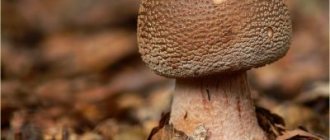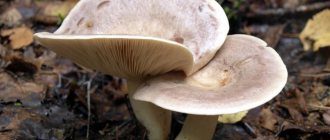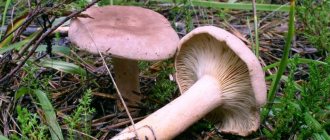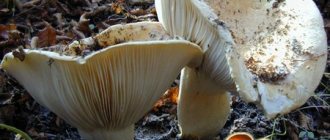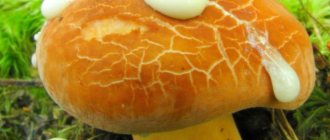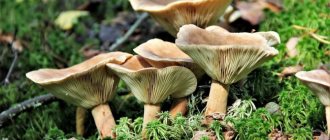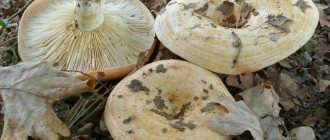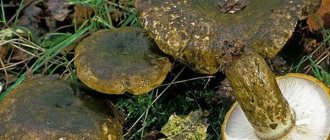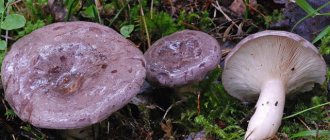Milky fungi (Lactarius) are a separate genus of lamellar fungi, numbering a very large number of species. The most famous of them are milk mushrooms, saffron milk caps, and volushki. Their name comes from the Latin word, which means “milk” or “milk-giving.” All these mushrooms belong to the Russula family. As a rule, in Europe, most species of these mushrooms are considered inedible, and some are even poisonous. While in Russia many are consumed as food after undergoing additional processing, such as salting or pickling. Such mushrooms are called conditionally edible. The mushroom about which the story will go is exactly one of them - the common milkweed.
a brief description of
Common milkweed, smooth milkweed, spurge, hollow milkweed, milkweed, blue milk mushroom, smooth mushroom... This mushroom has quite a few names. It belongs to a large species of laticifers, the Russula family. The main difference between this kind of mushrooms is the secretion of juice by the pulp or spore-bearing layer, similar to milk. Milk plants have a specific bitter taste. Like many other representatives of this species, smoothie is considered a conditionally edible mushroom. Mycologists classified it as this species because it requires additional processing before use and has some limitations in preparation.
Content:
- a brief description of
- Distribution areas and similar species
- Composition and beneficial properties
- Use in cooking
- Harm and dangerous properties
- Collection and storage
- conclusions
In European cuisine, where they like to use everything in its natural, raw form, the common milkweed is classified as a poisonous mushroom and is prohibited for consumption. And in our area, conditionally edible mushrooms are subjected to prolonged soaking, salting or repeated boiling, with repeated removal of the broth. And only then can such mushrooms be eaten.
The milkweed has a fairly wide cap, sometimes reaching up to 18 cm in diameter. One of its names - smoothie - was given precisely because of its smooth, fleshy cap. When it rains it becomes slippery. In young mushrooms it is more convex, but with age it settles and becomes depressed. The color varies from violet-lilac to fawn or even fawn-brown. In older varieties it fades and becomes pale lilac or yellowish-brown with barely visible concentric zones, or without them at all. The leg is smooth, cylindrical in shape. Has the same color as the hat. With age, it loosens and becomes hollow. The laticifer's plates are often light-colored; when damaged, they acquire a dark grayish color, mainly due to the milky sap. The pulp of the smoothie is dense, strong, white in color with a slight creamy tint. The juice released from it is white and milky in color. When dry it turns olive yellow. The pulp is very bitter in taste and has a specific smell. The spores are elliptical with ridge-like or warty ornamentation. The spore powder is pale, yellowish or cream in color.
History of the study
Genus Lactarius
was isolated in 1797 by the Dutch botanist-mycologist Christian Heinrich Person, initially under the name
Lactaria
as part of six species:
L. piperata
,
L. pallida
,
L. lateritia
,
L. torminosa
,
L. opaca
and
L. xylophila
.
Lactarius
as the genus name .
In 1801, the number of species in the genus was, according to Person, 17, and according to his contemporary, British botanist Samuel Frederick Gray, 12. Both researchers indicated the color of the cap as the main characteristic for separating species from each other. Swedish mycologist Elias Magnus Fries, in a publication of 1863, indicates the color and taste of the milky juice and the color of the plates as characters that allow the identification of intrageneric groups of species, thus distinguishing 3 groups: Dapetes
,
Piperites
and
Russulares
.
In 1889, the German mycologist Joseph Schröter proposed an idea (though not further developed) about the division of the genus Lactarius
into two:
Lactaria
and
Lactariella
based on the color of the spore powder and the microscopic characteristics of the spores.
An important stage in the development of ideas about the genus system was the classification proposed in 1888 by the French mycologist Lucien Quelet, based on the nature of the surface of the cap. Kele distinguished three sections: Glutinosi
,
Pruinosi
and
Velutini
, respectively with a sticky, dry smooth and velvety/hairy cap.
This system was later developed in the works of other scientists: A. Rikken, P. Conrad and J. E. Lange.
In subsequent works, the number of intrageneric taxa of different levels increased, mainly due to the systematization of new tropical species. Thus, the French mycologist Roger Aime distinguished in the genus Lactarius
3 subgenera:
Eulactarius
, as well as
Venolactarius
and
Lactariopsis
, including mainly tropical species.
The German mycologist Walter Neuhoff published a classification of the genus in 1956, where microscopic features of the structure of the pileipellis (cap skin) were first used to divide it into sections. This feature is one of the main ones today.
Modern ideas about the structure of the genus began to take shape with the appearance in 1979 of the work of American mycologists Lexemuel Ray Hesler and Alexander Hanchett Smith “North American species of Lactarius”, where both micro- and macroscopic characters were used to distinguish intrageneric taxa. Genus Lactarius
, thus, was divided into 6 subgenera, 18 sections and 5 subsections.
The latest major works devoted to the genus Lactarius today are the monographs by J. Heilmann-Clausen, A. Verbeken, J. Westerholt “Fungi of Northern Europe. vol. 2: The genus Lactarius”, M. T. Basso “Lactarius Pers.”, R. W. Rayner “British Fungus Flora: Agarics and Boleti. vol. 9 Russulaceae: Lactarius" and A. Bessette, A.R. Bessette, D.B. Harris "Milk mushrooms of North America".
Distribution areas and similar species
Smoothies are widespread in deciduous and coniferous forests of Eurasia. They often form mycorrhiza with trees such as spruce, pine or birch. They love high humidity, so they can often be found in large groups along swamps or on moss-covered soil, where conditions for growth and reproduction are most optimal. The common milkweed is one of the most common species of the genus of milkweeds. It grows in temperate latitudes, so it can be found with equal success in the forests of Europe, Siberia, the Urals, and even the Far East. The peak of fruiting of the smoothie occurs at the beginning of August and lasts until the end of October - the time when the greatest amount of precipitation falls. Cool autumn evenings, filled with the fresh aroma of warm rain, are their favorite time to appear.
Gladysh, or common milkweed, is a fairly recognizable mushroom, but it is often confused with such representatives of the same species as the gray milkweed (Lactarius flexuosus) and the red milkweed (Lactarius hysginus). But if you look closely, you can note some differences that are not immediately obvious. So, for example, the surface of the cap of the serushka is dry to the touch, the stem is solid, narrowed towards the base, and short. It tastes much sharper and sharper. And the meat-red milkweed is distinguished by its dark, terracotta color and pungent strong aroma. Gladysh also has similarities with the flaccid milkweed (Lactarius vietus), the juice of which turns gray under the influence of the external environment. And also with the gray lilac milky (Lactarius uvidus), the juice of which in the air acquires a lilac-violet hue.
Description
Yellow boletus, scientifically known as yellow boletus (lat. Boletus junquilleus), popularly known as yellow boletus, lemon mushroom or simply lemongrass, was named for its straw-yellow leg and golden tubular layer.
The height of the largest specimens exceeds 20 cm. The diameter of the cap, as a rule, fluctuates in the range of 5-15 cm, occasionally reaching 20 cm. In color and shape, the upper part of the young mushroom resembles half a potato, cut crosswise, but with age it straightens out.
The leg is thickened in the lower part, here it has a darker, sometimes reddish tint. When cut, the flesh is light, but not pure white, like boletus, but with a yellowish tint. Hence the names “Yellow boletus” or “Junquilla boletus” (from Spanish junquillo
- "light yellow"). A characteristic sign: when you cut the fruit body lengthwise, at the base of the stem you will notice a pungent odor reminiscent of carbolic acid or iodoform. The mushroom prefers deciduous forests and is most often found near oak trees, but its proximity to pine trees is also not uncommon.
https://youtube.com/watch?v=3gudnIHuvKw%3F
Composition and beneficial properties
The nutritional value of mushrooms depends on many different conditions. For example, young varieties contain much more nutrients, and fresh ones contain almost 90% water. The proteins of the milkweed contain such valuable amino acids as: tyrosine, glutamine, leucine and arginine. They are easily absorbed by the body and do not spend much money on breakdown. Mushroom fats contain such a useful substance as lecithin. Their number ranges from 0.1 to 0.9%. They also contain fatty acids:
- palmitic acid;
- stearic acid;
- butyric acid;
- acetic acid.
Milkweeds, like other representatives of this genus, contain phosphatides, essential oils and lipoids. In terms of carbohydrate composition, mushrooms are very close to vegetables, but there are others that are characteristic only of this class: glycogen, sugar alcohols, fiber. Their content reaches 16%. They do not contain starch, but they do contain glycogen, which in its composition resembles glycogen of animal origin. In mineral composition, laticifers are rich in potassium, phosphorus and calcium. They also contain trace elements such as iodine, zinc, copper and arsenic. They also contain substances such as mycoinulin and parodextrin, which are responsible for covering the mushrooms with mucus during long-term storage, as well as tregazolyte and lycosote, which provide their taste and nutritional value.
Some of the representatives of this class, due to their beneficial properties and valuable chemical composition, are used in the field of medicine. For example, from camelina and red camelina, the antibiotic lactarioviolin was identified during the process of secreting its milky juice, which has a negative effect on the bacteria that cause tuberculosis. Other types of lacticifers have a positive effect on cholelithiasis, acute and purulent conjunctivitis and other visual lesions. And some even contain antibiotics that inhibit the development of pathogenic bacteria, including Staphylococcus aureus.
Is spurge mushroom edible or not?
The milkweed is edible, has a sweetish taste, and the milky juice is not bitter. Soaking of fruit bodies before processing is not required. Boil the spurge before frying to make the flesh of the leg softer. Used for pickling or pickling. After processing, mushrooms acquire elasticity and are characterized by a high gastronomic rating. In the West, dishes with milkweed are considered delicacies.
Salting red-brown milk mushrooms for the winter
The milk jug is ideal for harvesting for the winter. Lamellar milkweeds are considered the most delicious after salting. For processing, take young mushrooms that are not damaged by insects. It is better to leave old specimens for pickling, because during the pickling process the fruit body loses its elasticity and characteristic crunch.
Before salting, mushrooms are processed:
- The harvest is poured out and sorted by size.
- Remove the protective film from the surface of the cap and stem.
- The lamellar layer is cleaned of grass and debris.
- Wash several times.
- To get rid of insects, soak in water with vinegar and salt. Keep in the solution for 2-3 hours.
Attention! After soaking, remove debris from the fruiting bodies and wash with hot water.
Hot salting method
To prepare mushrooms for the winter you will need:
- mushrooms – 5 kg;
- water – 5 l;
- bay leaf -10 pcs.;
- garlic – 2 heads;
- currant leaves – 15 pcs.;
- dill – 1 bunch (optional);
- salt – 10-12 tbsp. salt.
Cooking technology:
- To make the brine, boil water in an enamel pan, add salt and bay leaf.
- Sorted and washed mushrooms are placed in boiling brine for 30 minutes.
- The mushrooms are removed from the brine and washed with water.
- Pour salt into the pickling container and lay out the mushrooms in layers. Sprinkle with salt, dill, garlic.
- The top is covered with currant leaves.
- Close with a lid, which is pressed with a weight.
- After a few days, the mushrooms will release juice; they can be transferred to sterilized jars and closed for the winter.
The preparations are stored in the basement.
Use in cooking
Common milkweed is a first-class mushroom for pickling and pickling. During this processing, fermentation quickly occurs in it, due to which the smoothie acquires its characteristic sourish taste, which is so valued in Russian pickles. The mushroom is quite meaty, which allows it to be used after preliminary boiling for preparing various dishes. Most of the bitterness of the milkweed disappears during heat treatment, so well-fried mushrooms can also be eaten without subjecting them to cooking beforehand. In the finished dish, such smoothies will have a piquant, spicy, slightly bitter taste, like mushrooms seasoned with black pepper. Northern peoples have long revered this mushroom and often use it for culinary purposes. After all, their natural bitter taste repels pests, so milkweeds are less susceptible to attack by insect larvae and worms than other mushrooms. And since ancient times, Finland has had its own original recipe for making smoothies baked over a fire or grill.
Salting the common milkweed
Immediately before pickling, mushrooms should be soaked in water for several days. The infused water must be changed periodically. This is done in order to remove the bitterness. After this, the milkies are blanched for about 10 minutes. The correct course of the primary processing process is important, since its violation can lead to unnecessary consequences in the form of loss of the taste of the mushroom or intestinal upset. Cold and hot methods are used for salting the common milkweed. Hot is characterized by preliminary boiling of mushrooms after primary processing. The cold method skips this process.
Mushrooms in Korean
To prepare the dish you will need:
- smoothies or other bitter mushrooms;
- soy sauce;
- sugar;
- vinegar;
- ground coriander;
- garlic;
- hot red pepper;
- sesame;
- cilantro.
First boil the mushrooms several times, draining the processed water. It is advisable to leave a slight bitter aftertaste for piquancy. Season the prepared milkweed with soy sauce, add sugar and sprinkle with vinegar. Mix all this and taste the marinade to adjust the taste. Then sprinkle generously with spices. Pre-fry the sesame seeds in vegetable oil and pour the resulting mixture into the mushrooms. Add fresh green cilantro, mix everything and cool. After this, the Korean mushrooms are ready and can be served. Regular, non-bitter mushrooms are not suitable for this recipe, since having their own delicate taste, they will simply get lost in the spices and the dish will not give the desired taste and effect.
Interesting Facts
Amber milky.
Milkies have a number of interesting features:
- In many foreign countries these mushrooms are not eaten.
- In Russia, milk mushrooms (or milk mushrooms) are traditionally valued as pickling mushrooms.
- There is more protein in these mushrooms than in meat.
- With a high protein content, milkweed contains few calories, which is why it is a dietary product.
Consumption of milkweed lowers blood pressure and prevents the development of atherosclerosis. The gray-pink milk mushroom is not the most tasty and edible option among milk mushrooms. Therefore, it is quite rarely collected in the presence of other valuable mushrooms. However, in the absence of other options, it can be used for pickles.
It is important to prepare it correctly by soaking or heat treatment, otherwise the mushroom will be bitter and smell unpleasant. People with allergies and patients with ulcers, gastritis and gastroduodenitis should not eat mushrooms, since mushrooms are rich in chitin and are therefore poorly digestible.
Mushrooms should not be given to children, since their stomachs are not yet ready to digest such heavy food.
Collection and storage
It is good to pick mushrooms in dry weather, since if collected in rain or damp conditions, they can spoil faster. It is best to do this in the morning, when their aroma is stronger and their structure is stronger.
Mushroom pickers must comply with several conditions:
- collect only known types of mushrooms;
- use wicker baskets in which the mushrooms are well ventilated and remain fresh longer;
- lay with their caps down, and long-legged ones sideways.
- When collecting, twist or swing, then they are easier to separate.
It must be remembered that cutting mushrooms with a knife is not recommended, otherwise this may lead to rotting of the entire mycelium.
Best materials of the month
- Coronaviruses: SARS-CoV-2 (COVID-19)
- Antibiotics for the prevention and treatment of COVID-19: how effective are they?
- The most common "office" diseases
- Does vodka kill coronavirus?
- How to stay alive on our roads?
Fresh mushrooms are a perishable product. They need to be stored in a cool, ventilated area, or in the fresh air under a canopy. Usually they are scattered in a thin layer on a specially prepared surface: on tables, clean flooring, tarpaulin. They should not be piled up, kept in barrels, or exposed to direct sunlight or high humidity. The shelf life of milkweeds before pre-treatment should not exceed four hours.
How to salt milkweeds
Milky mushrooms are conditionally edible or conditionally inedible (whatever they are called now) mushrooms that are used exclusively for pickling (they are rarely pickled). Many are very bitter due to the bitter milky juice. In addition, milky juice decomposes into toxins in air and can cause food poisoning.
Only long-term soaking with constant replacement of water (or boiling) and subsequent cold 40-day salting partially or completely destroys these toxins. Such processing should not be neglected.
By the way, some of the milkweeds are first soaked and only then boiled. This is done in order to remove not only bitterness, but also an unpleasant odor. I have already written about how to pickle mushrooms; I won't repeat myself.
Don’t be afraid to collect milkweeds: milk mushrooms... trumpet mushrooms... pickles... Learn to recognize mushrooms. Choose the ones you like best. Remember that mushrooms are heavy food. It is possible to harm your health even with properly prepared salted mushrooms and porcini mushroom soup. As they say, everything needs moderation.
Literature:
- Vasilyeva L.N. Edible mushrooms of the Far East. – Vladivostok: Far Eastern Book Publishing House, 1978.
- Vishnevsky M.V. All about mushrooms. Popular encyclopedia. — Moscow: Prospekt, 2022. — 624 p.
- Life of plants in 6 volumes. T. 2. Mushrooms / Answer. ed. M. V. Gorlenko. – M.: Education, 1981.

